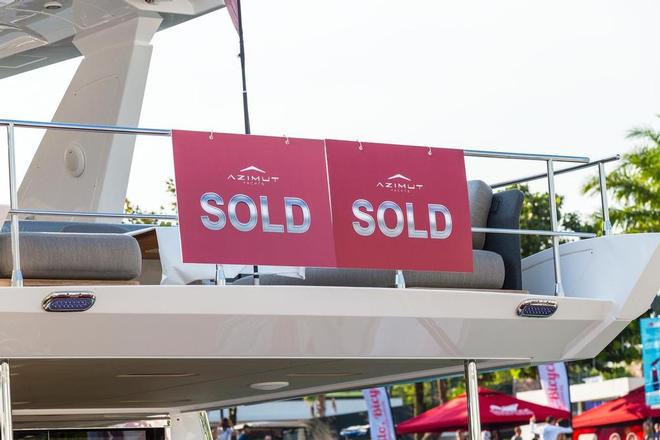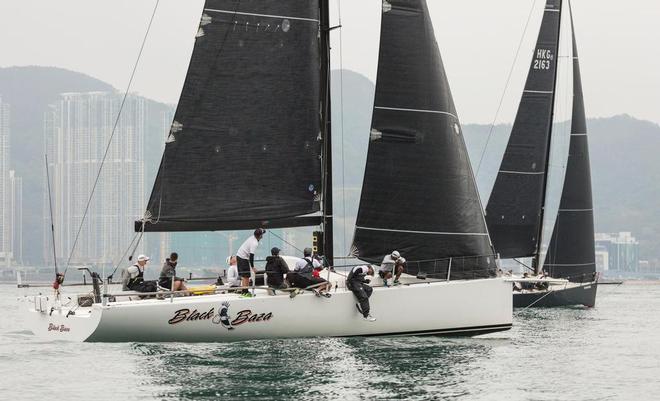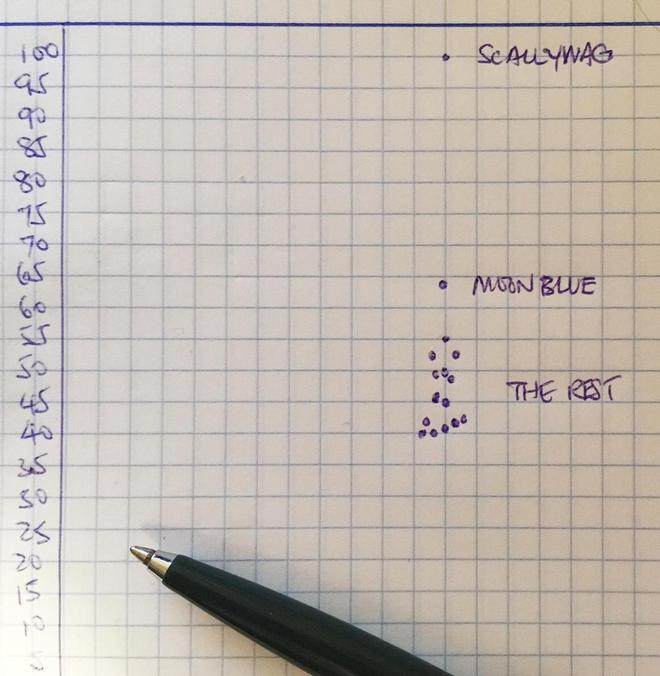| The latest sailing news from Asia and the world. |
18 Apr 2017 |
|
| |
  The Singapore Yacht Show and the San Fernando Race The Singapore Yacht Show and the San Fernando Race
 | | This is what boat shows are for, right? Singapore Yacht Show 2017. Guy Nowell © |
We have seen two major boating events in Asia recently, and observed both with much interest.
First there was the Singapore Yacht Show. We don't much like the titles of ‘biggest' and ‘best' because even among boat/yacht shows there are different flavours that do not bear comparison. However, it is probably safe to say that the Singapore Yacht Show is the 1 B to C boat show in Asia – without getting into quantitative analysis of the plethora of small-time teeny-tiny and generally lacklustre shows in this part of the world. CIBS (Shanghai) has more exhibitors on the call sheet, bit it is substantially a trade show.
Singapore, on the other hand, is firmly aimed at consumers. “It is first and foremost a brand show,” says organiser Andy Treadwell of Singapore Yacht Events. The object of the exercise is to put boats, boats, and more boats in front of the (potentially) buying public. It the show at which many manufacturers and dealers choose to launch regional and even world premieres.
It is held in an eminently suitable location (ONE?15 Marina), where the boat basin is surrounded by bars and restaurants, which help in providing a supporting ambience that is appreciated by visitors and exhibitors alike. When the show is over for the day (and some of the dealers' ‘socials' go on quite a long time!) then everyone can repair to the dockside establishments for further refreshments, and the party continues. It has long been noted that more business is transacted in the Guiness Bar at the London Boat Show than is ever written in the rest of the exhibition halls. Singapore has the same sort of after-hours action – you get the picture.
Singapore also has the Asia Pacific Yachting Conference and the Asian Boating Forum to move the tide of opinion along. We have been attending these events since their inception, and at long last are witnessing a shift from “European Experts Telling Asia What To Do” towards a greater understanding that Asia is a substantially different market (from Europe) in terms of boat usage and the engagement of the boating population – small as it is.
What did we learn in Singapore? Well, there was stuff that we know already – for example, that boat usage in Asia is more about short-time usage and entertainment than it is about two week cruises along the Côte d'Azur. Erwin Bamps, the ever-perceptive CEO of Gulf Craft, quite logically asked, “So why are we trying to sell ‘Mediterranean' motoryachts (80', 6 cabins, 12 guests) into Asia when what the customer actually wants is a party boat for a day trip?” Good point.
Secondly, Asia is very big. Whilst this means it has wonderful potential for cruising (unspoiled coastlines, secluded beaches, all the proper brochure stuff) there is indeed a long way between watering holes. Or fuel taps. For some that is not a problem – ‘expedition yachts' are becoming popular (fashionable?) among the well-heeled European boat-ocracy. They can cruise vast distances, and in a very self-sufficient manner, if that's what you like.
But a more tricky problem to be solved in Asia is ease of access. Singapore's entry/exit and operational regulations for privately owned vessels differ from the rules in Malaysia. Vietnam differs from Indonesia, and China still (to the best of our knowledge) doesn't have a tick-box for ‘Private Pleasure Vessel' in its registration documents. Many of the panellists and speakers at the Asia Pacific Yachting Conference exhorted listeners to go forth and lobby their governments to come up with a simple and regional marine policy with regard to pleasure boats. It's a good idea, and would do wonders, but I'm not holding my breath.
We have seen two major boating events in Asia recently, and observed both with much interest.
First there was the Singapore Yacht Show. We don't much like the titles of ‘biggest' and ‘best' because even among boat/yacht shows there are different flavours that do not bear comparison. However, it is probably safe to say that the Singapore Yacht Show is the 1 B to C boat show in Asia – without getting into quantitative analysis of the plethora of small-time teeny-tiny and generally lacklustre shows in this part of the world. CIBS (Shanghai) has more exhibitors on the call sheet, bit it is substantially a trade show.
Singapore, on the other hand, is firmly aimed at consumers. “It is first and foremost a brand show,” says organiser Andy Treadwell of Singapore Yacht Events. The object of the exercise is to put boats, boats, and more boats in front of the (potentially) buying public. It the show at which many manufacturers and dealers choose to launch regional and even world premieres.
It is held in an eminently suitable location (ONE?15 Marina), where the boat basin is surrounded by bars and restaurants, which help in providing a supporting ambience that is appreciated by visitors and exhibitors alike. When the show is over for the day (and some of the dealers' ‘socials' go on quite a long time!) then everyone can repair to the dockside establishments for further refreshments, and the party continues. It has long been noted that more business is transacted in the Guiness Bar at the London Boat Show than is ever written in the rest of the exhibition halls. Singapore has the same sort of after-hours action – you get the picture.
Singapore also has the Asia Pacific Yachting Conference and the Asian Boating Forum to move the tide of opinion along. We have been attending these events since their inception, and at long last are witnessing a shift from “European Experts Telling Asia What To Do” towards a greater understanding that Asia is a substantially different market (from Europe) in terms of boat usage and the engagement of the boating population – small as it is.
What did we learn in Singapore? Well, there was stuff that we know already – for example, that boat usage in Asia is more about short-time usage and entertainment than it is about two week cruises along the Côte d'Azur. Erwin Bamps, the ever-perceptive CEO of Gulf Craft, quite logically asked, “So why are we trying to sell ‘Mediterranean' motoryachts (80', 6 cabins, 12 guests) into Asia when what the customer actually wants is a party boat for a day trip?” Good point.
Secondly, Asia is very big. Whilst this means it has wonderful potential for cruising (unspoiled coastlines, secluded beaches, all the proper brochure stuff) there is indeed a long way between watering holes. Or fuel taps. For some that is not a problem – ‘expedition yachts' are becoming popular (fashionable?) among the well-heeled European boat-ocracy. They can cruise vast distances, and in a very self-sufficient manner, if that's what you like.
But a more tricky problem to be solved in Asia is ease of access. Singapore's entry/exit and operational regulations for privately owned vessels differ from the rules in Malaysia. Vietnam differs from Indonesia, and China still (to the best of our knowledge) doesn't have a tick-box for ‘Private Pleasure Vessel' in its registration documents. Many of the panellists and speakers at the Asia Pacific Yachting Conference exhorted listeners to go forth and lobby their governments to come up with a simple and regional marine policy with regard to pleasure boats. It's a good idea, and would do wonders, but I'm not holding my breath.
We have seen two major boating events in Asia recently, and observed both with much interest.
First there was the Singapore Yacht Show. We don't much like the titles of ‘biggest' and ‘best' because even among boat/yacht shows there are different flavours that do not bear comparison. However, it is probably safe to say that the Singapore Yacht Show is the 1 B to C boat show in Asia – without getting into quantitative analysis of the plethora of small-time teeny-tiny and generally lacklustre shows in this part of the world. CIBS (Shanghai) has more exhibitors on the call sheet, bit it is substantially a trade show.
Singapore, on the other hand, is firmly aimed at consumers. “It is first and foremost a brand show,” says organiser Andy Treadwell of Singapore Yacht Events. The object of the exercise is to put boats, boats, and more boats in front of the (potentially) buying public. It the show at which many manufacturers and dealers choose to launch regional and even world premieres.
It is held in an eminently suitable location (ONE?15 Marina), where the boat basin is surrounded by bars and restaurants, which help in providing a supporting ambience that is appreciated by visitors and exhibitors alike. When the show is over for the day (and some of the dealers' ‘socials' go on quite a long time!) then everyone can repair to the dockside establishments for further refreshments, and the party continues. It has long been noted that more business is transacted in the Guiness Bar at the London Boat Show than is ever written in the rest of the exhibition halls. Singapore has the same sort of after-hours action – you get the picture.
Singapore also has the Asia Pacific Yachting Conference and the Asian Boating Forum to move the tide of opinion along. We have been attending these events since their inception, and at long last are witnessing a shift from “European Experts Telling Asia What To Do” towards a greater understanding that Asia is a substantially different market (from Europe) in terms of boat usage and the engagement of the boating population – small as it is.
What did we learn in Singapore? Well, there was stuff that we know already – for example, that boat usage in Asia is more about short-time usage and entertainment than it is about two week cruises along the Côte d'Azur. Erwin Bamps, the ever-perceptive CEO of Gulf Craft, quite logically asked, “So why are we trying to sell ‘Mediterranean' motoryachts (80', 6 cabins, 12 guests) into Asia when what the customer actually wants is a party boat for a day trip?” Good point.
Secondly, Asia is very big. Whilst this means it has wonderful potential for cruising (unspoiled coastlines, secluded beaches, all the proper brochure stuff) there is indeed a long way between watering holes. Or fuel taps. For some that is not a problem – ‘expedition yachts' are becoming popular (fashionable?) among the well-heeled European boat-ocracy. They can cruise vast distances, and in a very self-sufficient manner, if that's what you like.
But a more tricky problem to be solved in Asia is ease of access. Singapore's entry/exit and operational regulations for privately owned vessels differ from the rules in Malaysia. Vietnam differs from Indonesia, and China still (to the best of our knowledge) doesn't have a tick-box for ‘Private Pleasure Vessel' in its registration documents. Many of the panellists and speakers at the Asia Pacific Yachting Conference exhorted listeners to go forth and lobby their governments to come up with a simple and regional marine policy with regard to pleasure boats. It's a good idea, and would do wonders, but I'm not holding my breath.
 | | Black Baza. RHKYC San Fernando Race 2017. © RHKYC/Guy Nowell |
Moving swiftly from a predominantly motor boat occasion to one that is pure sailing – the biennial RHKYC San Fernando Race started last Wednesday, the 100' Scallywag sliced 15 hrs off the existing record, and the fact that there was a quality fleet of fast 40s seemed to slip out of the headlines. Reminder: that ‘15 hrs' thing is certainly impressive, but in 1987 Charley, one of the original 70' ULDB sleds, actually reduced the record by an even more chunky 25 hrs! Was the beginning of the era in which cheque book sailing really got going? When does a new record merely equate to bringing a howitzer to a knife fight?
Down Under, and the media attention garnered by the Rolex Sydney to Hobart Race is always limited to two things – which boat is first past The Heads, and who wins Line Honours. As soon as that is decided (and there have been many noble battles between the big boats, right up to the finish line) the media seems to lose interest, as if the general public is too dim to understand that an even more important battle is the one for the handicap result – the Tattersall's Cup.
This time, Scallywag claimed not only Line Honours, but IRC Overall as well. And the next boat down the LOA list was a 65' Premier Cruiser, Moonblue 2. But the main competition was among the 40-footers. On corrected time, Black Baza (Ker 42, Steve Manning / Anthony Root) won IRC 1, and Ambush (Mills 41, Joachim Isler / Drew Taylor) beat both the TP52s in the race. This race gave Black Baza the fourth card of an Asian Offshore Flush - Overall wins in the Vietnam Race 2015, the Rolex China Sea Race 2016 and the Hainan Race 2016, and now an IRC 1 victory on the way to San Fernando.
Oddly enough, it wasn't a ‘record breaking year' as far as the weather was concerned – the two TP52s Free Fire and Stardard Insurance Centennial, both finished outside Free Fire's previous record time. A bit like statistics or accountancy, you can make the numbers mean whatever you want them to mean. So here, to make it all a bit more visual, is a little graphic. This is the size distribution of the San Fernando fleet, with 100ft at the top of the page, and zero at the bottom. So, where was the real race? As usual, answers on a postcard please. Presumably, and until someone comes along with a bigger boat, or maybe one with more hulls, the Scallywags will cruise around Asia collecting records. We used to call it ‘pot hunting'.
 | | San Fernando Race 2017. Size matters. Guy Nowell © |
Guy Nowell, Sail-World Asia Editor
|
|
|
|
|
|